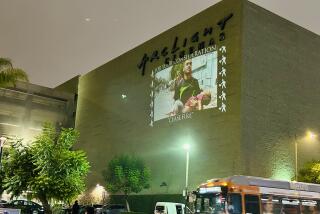Arts Groups Observe World AIDS Day
- Share via
World AIDS Day was observed Friday with protests, arrests and more than 600 arts institutions throughout the United States participating in “A Day Without Art” to draw attention to the impact AIDS has had on the arts community.
Scores of major art galleries closed their doors for the day. Other museums opened free of charge, suggesting that patrons make donations to AIDS organizations instead.
In addition to the unprecedented action that drew together private galleries and museums, universities and theaters, police in Washington arrested 78 AIDS activists who sat in the street in front of the White House and chanted, “People with AIDS under attack. Act up, fight back.”
The activists also issued a “report card” giving President Bush failing or incomplete marks for his response to the deadly epidemic that has stricken more than 100,000 Americans.
Bush has failed to provide a national AIDS strategy, has not pushed for adequate funding for prevention, care, research and treatment and has not responded to the growing burden AIDS is placing on the nation’s health care system, said Rene Durazzo, who represented more than a dozen groups, including the National Assn. of People With AIDS and the AIDS Action Council.
Bush said in a statement: “Though there is no cure for AIDS at the present time, we will continue the most vigorous research efforts.”
In Burlingame, Calif., 100 demonstrators from the AIDS Coalition to Unleash Power gathered at the western regional headquarters of Burroughs Wellcome to protest the high price of the antiviral drug AZT. Police said 16 people were arrested for trespassing.
“We’re asking Burroughs to lower the price by 50% or to open up its books to justify the current price,” said David Stearns, a spokesman for the group.
Even after a recent 20% price cut, AZT costs about $6,400 a year for a full dose.
Burroughs, which closed the facility Friday in anticipation of the protest, could not be reached for comment but has consistently defended the price.
Other protests commemorating World AIDS Day were scheduled to be held throughout Northern California.
The J. Paul Getty Museum in Malibu dimmed the lights in its photography galleries to honor Sam Wagstaff, a photography collector who died of AIDS in 1987.
In Raleigh, N. C., a church opened its doors for friends and relatives of AIDS victims to light candles. The Solomon R. Guggenheim Museum in New York was draped with a giant black banner.
The DeCordova Museum in Lincoln, Mass., draped many of its paintings, on loan from corporations, in black shrouds. The Metropolitan Museum in New York pulled down Pablo Picasso’s famed “Portrait of Gertrude Stein” and replaced it with a note about the impact of AIDS on the arts community.
Boston’s Museum of Fine Arts opened an exhibit called “Memento Mori,” a collection of etchings by Boston artist James Hansen, chronicling a friend’s death from AIDS, and displayed dozens of panels of the quilt from the Names Project.
In an example of lesser-known institutions joining in, Waco-Southern Illinois University at Edwardsville, Ill., draped a four-building arts complex with fabric and marked the entrance with a giant “X.”
More to Read
Sign up for Essential California
The most important California stories and recommendations in your inbox every morning.
You may occasionally receive promotional content from the Los Angeles Times.










